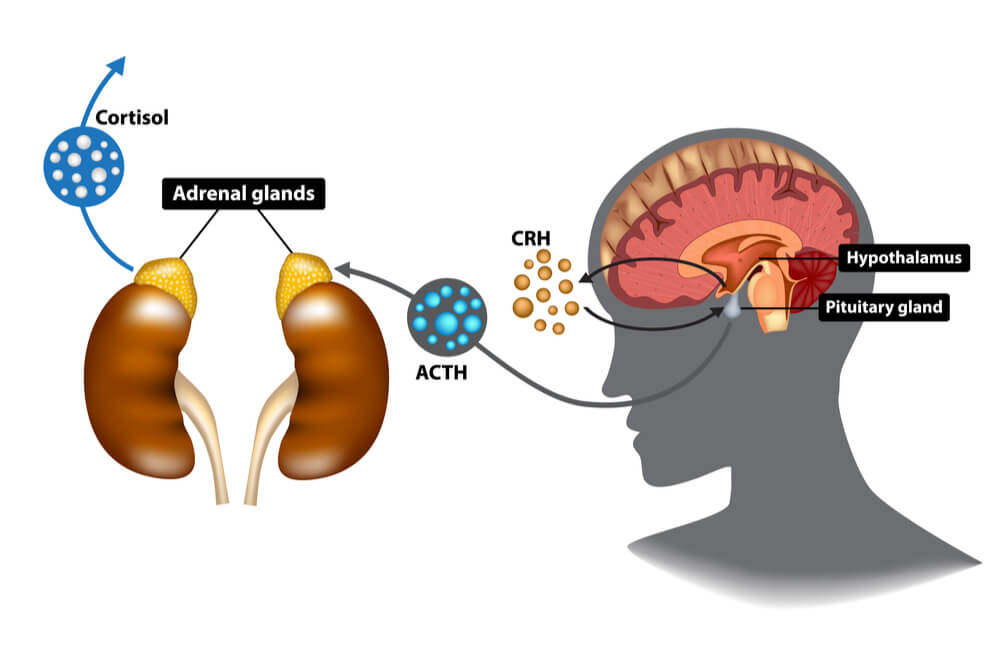 |
Dr. Reshma Patel, MD Functional Medicine Doctor Adrenal Health Expert |
Based on an interview for WebFMD
Definition | Stages | Symptoms | Causes | Testing
It’s a typical Wednesday afternoon. You’ve already had three (or four) cups of coffee to get you through the morning and now you’re crashing hard. The situation is dire. Three more hours until you get to leave work and you just can’t find the strength to keep your eyes open.
This is not your normal level of “tired”, no, this is absolute soul-crushing fatigue. Later on that night, after you finish your endless list of chores and are finally ready to go to bed, you can’t fall asleep and wake up every two hours. You were expecting an amazing night of sleep.
What is going on?
If any of these sounds familiar, you aren’t alone. Commonly known as adrenal fatigue, adrenal exhaustion, or in medical terms HPA axis dysfunction, this widespread dysregulation affects a large number of people in the western world every year, although it is not always properly diagnosed or treated.
Related post: HPA Axis Dysfunction Treatment.
What Is HPA Axis Dysfunction?

The hypothalamic–pituitary–adrenal (HPA) axis is a hormone-based system that regulates the body’s reaction to stress. This ensures that the body can respond immediately to stressful events and return to a normal state just as quickly.[1]
When we experience stress, the brain communicates this feeling to the adrenal glands signaling them to produce stress hormones. A stressful situation triggers a reaction in the hypothalamus in the brain, which then continues through the pituitary gland, and ends in the adrenal glands.
The adrenals produce several hormones, such as cortisol and adrenaline that play a key role in our “fight or flight” stress response to threatening situations. As a part of this release of hormones, we become more alert. Sugar is released in the bloodstream to supply energy to fight or run. Think of our ancestors running away from a woolly mammoth, for instance. For that short period of time, they need all the energy and focus they could get.
The problem is that in our modern lives we experience stressful events that are not life threatening every day, yet they still trigger our fight or flight response. As a result, the brain constantly signals the adrenals to make more cortisol.
Overtime, the adrenals can’t keep up with the demand. They are no longer able to make enough cortisol or other key hormones, which can cause them to get “burnt out”. Eventually, this leads to HPA axis dysfunction. Common symptoms include low energy, exhaustion, and mood swings, although you may experience other symptoms as well. Since no system in the body works in isolation, other systems may also be affected, leading to more imbalances.
The Three Stages of HPA Axis Dysfunction

HPA axis dysfunction doesn’t happen overnight. It can evolve over the course of several months or years. While everyone may experience and respond to stress a little differently, there are essentially three major stages as HPA axis dysregulation develops:
First Stage: “Wired, but Tired” – High cortisol levels
The first stage of HPA axis dysfunction is often characterized with an over secretion of cortisol. As a result, you may notice rapid energy fluctuations throughout the day, going between having too much energy to extreme, unrelenting exhaustion.
It’s a vicious cycle: you can’t fall asleep at night and wake up exhausted in the morning. You drink coffee to stay alert, only to crash again hours later. Then at night you can’t fall asleep and wake up even more exhausted the next day.
Second Stage: Low cortisol levels
In the second stage, once the adrenals get burnt out, they don’t produce enough cortisol, so you end up with low levels. The rapid energy fluctuations from stage one shifts into more extreme exhaustion followed by symptoms such as “brain fog”, weight gain, hair loss (mainly in women) and low libido in men due to due to “cortisol steal.” (This is where hormone production is directed toward cortisol and away from sex steroid hormones, such as testosterone).
These symptoms can vary from one person to another and may keep evolving as more body systems are affected.
Third Stage: Very low/No cortisol levels
Eventually, you reach the third stage, where the brain continues to tell the adrenal glands to make cortisol, but they no longer produce any at all. Tests in this phase can show very low cortisol levels or even a “flat line”.
Common Symptoms of HPA Axis Dysfunction
I often see patients with HPA axis dysfunction who also suffer from other medical conditions. As such, the list of symptoms may be very different from one person to another. With that said, most common symptoms include:
- Wake up tired, or feel fatigue throughout the day
- Cognitive issues such as “brain fog”
- Trouble falling asleep
- Lower tolerance to stress, irritability, short temper
- Weight gain, especially in the midsection
- A weak immune system, getting sick more often
- Hair loss in women
- Low libido in men (80% of DHEA is produced by the adrenals).
Common Causes of HPA Axis Dysfunction
I believe that 9 out of 10 people in the Western world experience HPA axis dysfunction to some degree. While the actual causes may be different in each case, here are the most common ones:
Stress of Modern Life
 Modern life is often a major source of stress for many people. It also leaves us with less time to engage in activities that naturally balance and reduce stress.
Modern life is often a major source of stress for many people. It also leaves us with less time to engage in activities that naturally balance and reduce stress.
Long commute times to work are the norm. We work longer hours, including evenings and weekends. As a result, we spend less time with our families and minimize the time we would normally be in nature recharging.
I hear it all the time from patients who have way too much on their plate, often doing the jobs of two people at work, only to come home and continue working. They’re just running around from one task to another like a machine that operates on constant “auto pilot” survival mode.
Our ancestors also had stress of course, but never before in human history was there so much constant daily stress, with so little family interaction, community support, outdoor activities and sunshine.
We have clearly stepped away from the natural rhythm of life that has been nourishing our minds and bodies for centuries.
Our Subconscious Perception of Stress
I find that a big part of the problem of stress, is our subconscious perception of stress. We are not actively saying we want to be stressed, but our stress response is elicited by the way we perceive certain events, which determines whether the “fight or flight” sympathetic or the calming parasympathetic nervous system will be triggered. I believe this is where the power lies.
I will discuss this in much more details in my next article on HPA axis dysfunction treatment.
Modern Diet
Modern life has also led to a new type of eating, which includes “modern” processed foods, packaged foods, refined carbs, sugary drinks, with many artificial ingredients, toxins and chemicals we have never been exposed to before.
The result is an unhealthy nutritionally deficient, sub-optimal diet that is very different from the whole food-based diet our ancestors used to eat. Not only can these processed foods damage and stress our body, they often lack the basic nutrients our body needs to heal and restore.
Lack of Sleep
In our attempt to become a super productive society, we don’t always pay enough attention to our sleep or consider how lack of sleep affects us. Not having adequate sleep can significantly impair our organs and how our body functions, including the HPA axis and the adrenals. Sleep is essential in order for the body to detoxify, heal damaged tissues, regenerate and restore its reserves.
Not surprisingly, many studies have shown that people who get less sleep have higher rates of breast cancer, dementia, Alzheimer’s disease and other health conditions.
Physical or Emotional Trauma
Another type of stressor that can cause adrenal dysfunction is actual physical trauma as a result of an accident, injury, or surgery. Physical stress can also occur by overtraining or excessive exercise often seen in athletes or in people that are engaged in high demanding activities such as marathons.
Often overlooked, an emotional trauma such as loss of a loved one, a divorce or other stressful events can also affect the health of the HPA axis.
Underlying Chronic Conditions
Certain chronic conditions such as autoimmune disease, hypothyroidism, mold illness and others can lead to HPA axis dysfunction, especially when the underlying root cause is not addressed for a long time. For this reason, looking at your medical history is always a key part of the treatment to identify underlying causes and risk factors that may be unique to you. In fact, because of the influence of medical conditions in the treatment of HPA axis dysfunction, each case can be completely different.
Testing for HPA Axis Dysfunction
 I’m always very thoughtful about not ordering unnecessary tests. If a certain test isn’t going to change the course of the treatment, why order it? In addition, tests often produce a lot of plastic waste including boxes and tubes that have a big negative impact on our environment.
I’m always very thoughtful about not ordering unnecessary tests. If a certain test isn’t going to change the course of the treatment, why order it? In addition, tests often produce a lot of plastic waste including boxes and tubes that have a big negative impact on our environment.
While the tests can vary from one patient to another, the most basic test for HPA axis dysfunction is a saliva test to measure cortisol levels. To evaluate the different cortisol fluctuations throughout the day, the test is usually done four times a day; morning, mid-morning, early afternoon, and right before bed.
I usually have my patients tested on a typical work day to evaluate the stress they are normally exposed to. I may adjust the timing protocol for special circumstances, for example, before a big event like a presentation or meeting at work. In addition to testing the cortisol levels, we often test the DHEA levels in both men and women, as these are usually affected in HPA dysfunction.
There are times I find that the cortisol saliva tests may not be needed, however. I often see patients where HPA axis dysfunction is caused by another medical condition such as mold illness, where it is clear based on the symptoms that the adrenals are also impacted. In these cases, the focus of the testing and treatment goes to the primary condition first. In fact, the adrenals may return to normal function if the root cause is addressed without the need to specifically treat the HPA axis dysfunction.
HPA Axis Dysfunction: Final Thoughts
Although HPA axis dysfunction is a very common issue, it is not always properly diagnosed or treated. The good news is that the body has the ability to heal and return to normal function if the underlying cause is identified and addressed.
Use this information to educate yourself and work together with your health practitioner to evaluate the potential causes and treatment options you may have.
In our next article, I will discuss my approach to the treatment of HPA axis dysfunction, including diet, supplements and natural ways to help the body cope with stress and recover.
Read Next
HPA Axis Dysfunction Treatment: The Functional Medicine Approach.


This is a very helpful and informative article on HPA suppression Doctor Reshma. Thank you.
My question is does low production of HPA have any bearing or impact on breathing like tightness of chest, and difficulty in breathing? Consider the scenario where exhaustive heart and lungs tests return negative results i.e., they look good or normal. Tests include blood, X-ray, MRI or CT scans, treadmill stress test, pulmonary test – huffing and puffing into tubes, etc. Could HPA axis suppression be the root cause for breathing difficulty?
There is something called Vocal Cord Dysfunction, VCD, which can make it hard to breathe. It may be worth looking into – it was for me.
Thank you Dr Reshma Patel,
This is an excellent article. So well done and helpful
Best regards
Terry Power Chiropractor Acupuncturist Naturopath
I’ve been absent for some time, but now I remember why
I used to love this website. Thank you, I’ll try and check back more often. How frequently you update your web site?
Excellent article! Learned so much!